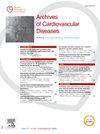自膨胀瓣膜与球囊膨胀瓣膜治疗功能不全右心室流出道的早期疗效比较分析
IF 2.3
3区 医学
Q2 CARDIAC & CARDIOVASCULAR SYSTEMS
引用次数: 0
摘要
自膨胀瓣膜(sev)是替代球囊膨胀瓣膜(bev)用于经导管肺瓣膜置换术(TPVR)治疗功能不全右心室流出道(RVOTs)患者的新兴选择,但其安全性和有效性仍有待进一步研究。目的比较TPVR患者sev与bev的特点及预后。方法前瞻性分析2022年1月至2024年6月期间接受TPVI治疗的139例患者的临床和早期随访数据,使用Edwards SAPIEN 3 (ES3) bev或Venus-P sev。结果矮化:男性59.7%,中位体重65 kg;66.2%接受ES3瓣膜(n = 92), 33.8%接受Venus-P瓣膜(n = 47)。ES3的中位年龄为33.2岁(IQR: 19.7-42.8), Venus-P的中位年龄为44.7岁(IQR: 32.6-54.1)。0.001)。53.2%的患者为法洛四联症。病变类型包括狭窄(13.7%)、肺反流(66.9%)和混合型(19.4%)。ES3和Venus-P病例中,原生RVOTs分别占5.4%和31.9%,而修补RVOTs分别占41.3%和68.1%。中位瓣膜直径为36mm (IQR: 34-36), ES3 (P <;0.001)。所有移植均成功。ES3的中位透视时间为18 min (IQR: 13-27), Venus-P的中位透视时间为22.6 min (IQR: 19-26) (P = 0.02)。术后中位RVOT最大速度为2 m/s (IQR: 1.6-2.5)。4.3%为中度瓣膜功能不全,6.5%为轻度,89.2%为无瓣膜功能不全。中度不良事件发生率为7.2% (ES3组为3.3%,Venus-P组为14.9%;P = 0.01),需要治疗的室性心律失常占9.4% (ES3组2.2%,Venus-P组23.4%;P & lt;0.001)。结论sev治疗TPVR有效,但其不良事件和室性心律失常发生率高于bev,需长期随访。本文章由计算机程序翻译,如有差异,请以英文原文为准。
A comparative early outcome analysis of self-expandable and balloon-expandable valves in the management of dysfunctional right ventricular outflow tracts
Introduction
Self-expandable valves (SEVs) are emerging alternatives to balloon-expandable valves (BEVs) for transcatheter pulmonary valve replacement (TPVR) in patients with dysfunctional right ventricular outflow tracts (RVOTs), though their safety and efficacy remain underexplored.
Objective
To compare patient characteristics and outcomes of SEVs and BEVs in TPVR.
Method
Clinical and early follow-up data were prospectively analyzed for 139 patients who underwent TPVI between January 2022 and June 2024 using Edwards SAPIEN 3 (ES3) BEVs or Venus-P SEVs.
Results
Cohort: 59.7% male, median weight 65 kg; 66.2% received ES3 valves (n = 92) and 33.8% Venus-P (n = 47). Median age was 33.2 years (IQR: 19.7–42.8) for ES3 and 44.7 years (IQR: 32.6–54.1) for Venus-P (P < 0.001). Tetralogy of Fallot was the underlying diagnosis in 53.2%. Lesion types included stenosis (13.7%), pulmonary regurgitation (66.9%), and mixed (19.4%). Native RVOTs were present in 5.4% of ES3 and 31.9% of Venus-P cases, while patched RVOTs were found in 41.3% and 68.1%, respectively. Median valve diameter was 36 mm (IQR: 34–36) for Venus-P and 26 mm (IQR: 23–29) for ES3 (P < 0.001). All implantations were successful. Median fluoroscopy time was 18 min (IQR: 13–27) for ES3 and 22.6 min (IQR: 19–26) for Venus-P (P = 0.02). Postoperative median RVOT maximum velocity was 2 m/s (IQR: 1.6–2.5). Valve insufficiency was moderate in 4.3%, mild in 6.5%, and absent in 89.2%. Moderate adverse events occurred in 7.2% (3.3% ES3, 14.9% Venus-P; P = 0.01), and ventricular arrhythmias requiring therapy in 9.4% (2.2% ES3, 23.4% Venus-P; P < 0.001).
Conclusion
SEVs are effective for TPVR but have higher rates of adverse events and ventricular arrhythmias than BEVs, necessitating vigilant long-term follow-up.
求助全文
通过发布文献求助,成功后即可免费获取论文全文。
去求助
来源期刊

Archives of Cardiovascular Diseases
医学-心血管系统
CiteScore
4.40
自引率
6.70%
发文量
87
审稿时长
34 days
期刊介绍:
The Journal publishes original peer-reviewed clinical and research articles, epidemiological studies, new methodological clinical approaches, review articles and editorials. Topics covered include coronary artery and valve diseases, interventional and pediatric cardiology, cardiovascular surgery, cardiomyopathy and heart failure, arrhythmias and stimulation, cardiovascular imaging, vascular medicine and hypertension, epidemiology and risk factors, and large multicenter studies. Archives of Cardiovascular Diseases also publishes abstracts of papers presented at the annual sessions of the Journées Européennes de la Société Française de Cardiologie and the guidelines edited by the French Society of Cardiology.
 求助内容:
求助内容: 应助结果提醒方式:
应助结果提醒方式:


